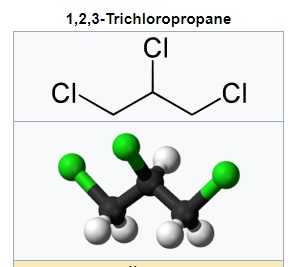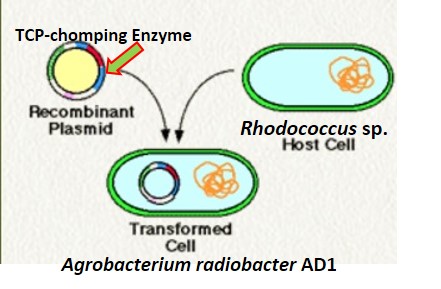

The toxic chemical, called TCP, or 1,2,3-trichloropropane, is a 3-carbon hydrocarbon, with three chlorines, that is artificially made in the chemical manufacture of soil fumigants. It is toxic to humans and persistent in the environment.
Dow Chemical and Shell are responsible for making the soil fumigants that are contaminated with 1,2,3-TCP, or Trichloropropane (TCP). It was deceptively registered it as an active ingredient when the fumigants were sold to farmers, starting in the 1940s and all the way until the 1990s when TCP was finally banned by our environmental protection laws.
But by then, the insidious presence of TCP had leached from the soil into the ground water, and the TCP, which does not biodegrade in nature, has contaminated well-water that depends on this TCP-tainted ground water. In California, thousands of people have been drinking and cooking with TCP-contaminated water, and getting sick from it, due to the deception by the two companies, who knew all along that it was both dangerous and unnecessary in their products. (read more on this here).
As a Microbe Whisperer, I wondered, what microbes can bioremediate the water that is contaminated with 1,2,3 TCP?
The answer is, no natural microbes appear to degrade 1,2, 3 TCP, at least, not enough to lower it down to a concentration that will not cause cancer. But, a group of microbiologists genetically engineered a microbe, by using a small circlet of DNA, called a plasmid, and adding to this plasmid, genes from a microbe that can do something close to getting the 1,2, 3 TCP degraded down to harmless products.
Bosma et al, in AEM, July 2002, p. 3582–3587, put it this way:
“The critical step in the aerobic degradation of TCP is the initial dehalogenation to 2,3-dichloro-1-propanol. We used random mutagenesis and screening on eosin-methylene blue agar plates to improve the activity on TCP of the haloalkane dehalogenase from Rhodococcus sp. m15-3 (DhaA). A second-generation mutant containing two amino acid substitutions, Cys176Tyr and Tyr273Phe, was nearly eight times more efficient in dehalogenating TCP than wild-type dehalogenase.
The evolved haloalkane dehalogenase was expressed under control of a constitutive promoter in the 2,3-dichloro-1-propanol-utilizing bacterium Agrobacterium radiobacter AD1, and the resulting strain was able to utilize TCP as the sole carbon and energy source. These results demonstrated that directed evolution of a key
catabolic enzyme and its subsequent recruitment by a suitable host organism can be used for the construction
of bacteria for the degradation of a toxic and environmentally recalcitrant chemical.”
In simpler language: A microbe that already has some genes for degrading the next product after 1,2,3 TCP degradation, was subjected to mutation, artificially, and by using common microbe whispering tricks for enrichment and screening, a microbe was found with the enzyme that could do what we want it to do, chow down on 1,2,3 TCP. The genes for this new enzyme were then placed on a plasmid and this circlet of DNA was popped into another bacterium, Agrobacterium radiobacter, AD1, that has a specialized way of making sure the switch for this enzyme from Rhodococcus sp., is turned on all the time. The end result? A new microbe that can feed off of the toxic 1,2,3 TCP and remove it from the soil!
Way to go fellow Microbe Whisperers!
The next step is to find a way to fix or attach millions of these microbes to some non-toxic material, that we can spread over, or under the ground water sources, and also apply to the contaminated wells, so they can eliminate all the TCP by feeding on it.
More Microbe Whispering on that soon!
by Dr. JeM YinJoy









